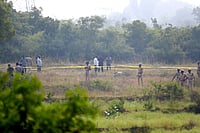The Bharatiya Janata Party, which swooped state after state following a huge mandate in 2014 Lok Sabha elections, has seen its footprints shrink in 2019.
With Jharkhand on Monday, the saffron party has lost five key states in the past 12 months.
When the BJP came to power at the Centre in 2014, it commanded just seven states. Riding on a Modi wave, the party, then, won as many as 21 states by 2018.
It made inroads into non-NDA citadels -- from Jammu and Kashmir to Assam -- the BJP managed to leave its mark.
Then came December 2018. The BJP-led governments faced defeat in Madhya Pradesh, Chhattisgarh and Rajasthan, weakening the party's grip over the Hindi heartland.
The saffron footprint shrunk further when the BJP-PDP coalition government in Jammu and Kashmir -- an alliance that cost the PDP dearly -- collapsed in 2018. In Andhra Pradesh, its ties with TDP broke off, thus, downsizing its shadow over the landscape even more.
Even Karnataka put the BJP’s strength to test when B.S. Yediyurappa had to resign after four days as Chief Minister in 2018. Almost a year later, it took the BJP 'Operation Kamala' to topple to Congress-JD(S) coalition government and return to power.
Though the BJP returned to power at the Centre with a bigger mandate in May 2019, the performance could not be mirrored in the states.
In Maharashtra and Haryana assembly elections in October, the BJP saw a dip in its seat share. In Haryana, its seat share dropped to 40. The party had won 47 seats in previous elections in 2014, according to the Election Commission. That came as a huge disappointment for former Chief Minister Manohar Lal Khattar who aimed at "Abki Baar 75 paar".
Nonetheless, BJP formed the government in Haryana but not without the support of JJP leader Dushyant Chautala and some political drama.
In Maharashtra, home to its Hindutva ideologue RSS, the number of seats for the BJP dropped from 122 in 2014 to 105 in recent elections.
In the power tussle that followed the poll results, BJP tried everything to retain the state -- even a hush-hush government formation that lasted not more than three days -- but nothing paid off.
With BJP losing its command over Maharashtra, the party’s footprints significantly shrunk. From 22 states in 2017, the party was left with 17.
Losing Madhya Pradesh, Rajasthan and Chhattisgarh -- three large states and its strongholds -- in one go was a tremendous loss.
But of all, Maharashtra was a major blow, for as the BJP lost both the state as well as a protracted political battle.
As BJP faced a staggering defeat in Jharkhand, the party is now left with 16 states.
It now governs 35 per cent of the country's landmass in comparison to over 71 per cent in 2017 when it hit the peak of its popularity.
BJP's defeat in five states within a year, despite fulfiling some of the key promises it made in its 2019 Lok Sabha manifesto -- abrogation of Article 370, Citizenship (Amendment) Act and Ram Mandir -- indicates, once again, that it's the local issues that decide the fate of an election.
The people seem to have rejected the national narrative built by the BJP in the state over the issues of Article 370, the Citizenship Amendment Act and the NRC.
The Modi Wave, too, has not been enough to cajole the voters. In a tribal state, again, it has been the local call.

























